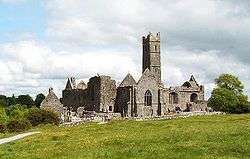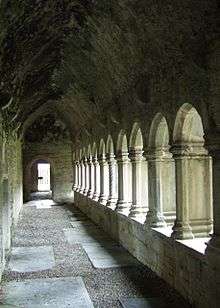Quin Abbey
| Mainistir Cuinche | |
 Quin Abbey | |
 Location within Ireland | |
| Monastery information | |
|---|---|
| Other names | Quin Friary |
| Order | Franciscans |
| Established |
c. 1350 (church), 1433 (abbey) |
| Disestablished | 1541 |
| People | |
| Founder(s) | MacNamara family |
| Architecture | |
| Heritage designation | National Monument |
| Style | Gothic |
| Groundbreaking | 1402 |
| Completion date | 1433 |
| Site | |
| Location | Quin, County Clare, Ireland |
| Coordinates | 52°49′9.43″N 8°51′46.87″W / 52.8192861°N 8.8630194°WCoordinates: 52°49′9.43″N 8°51′46.87″W / 52.8192861°N 8.8630194°W |
| Public access | yes (strict opening hours) |
| Official name | Quin Abbey |
| Reference no. | 15 |

Quin Abbey, in Quin, County Clare, Ireland, was built between 1402 and 1433 by Sioda Cam MacNamara, for Fathers Purcell and Mooney, friars of the Franciscan order. Although mostly roofless, the structure of the abbey is relatively well preserved. There is an intact cloister, and many other surviving architectural features make the friary of significant historical value.[1]
A far earlier monastery had existed on the site, which burned down in 1278. A Norman castle was built soon after by Thomas de Clare, a military commander.[2] The foundations of the castle's enormous corner towers can still be seen. Around 1350 the castle, by then a ruin, was rebuilt as a church by the McNamara clan. It was this structure which the MacNamaras subsequently rebuilt as the present abbey, properly called a friary. In 1541, during the Reformation, King Henry VIII confiscated the friary and it passed into the hands of Conor O'Brian, Earl of Thomond. In about 1590 the MacNamaras regained control of the site and once again set about repairing and restoring it. In about 1640 the building became a college and is alleged to have had 800 students. Oliver Cromwell arrived only 10 years later, murdering the friars and destroying the friary. In 1671 the building was once again restored, but never regained its former status. Eventually in 1760 the friars were expelled, although the last Friar, John Hogan, remained there until his death in 1820, by which time the buildings were ruined by neglect.[3]
The abbey is roughly 9 miles from Ennis. A visitor centre is located near the building and the structure and grounds can be visited free of charge. A caretaker is permanently based at the monument. Floodlighting has recently been installed. The graveyard surrounding the friary is still in use.
References
- ↑ 75th Annual Report of the Commissioners of Public Works in Ireland; Clonmacnois, King's County. Dublin: A. Thom & Co, 1906
- ↑ Brian Hodkinson, Was Quin Castle Completed?, North Munster Antiquarian Journal, Vol. 44, 2004, pp.53-8
- ↑ C. P. Meehan, The Rise & Fall of the Irish Franciscan Monasteries; James Duffy & Sons, Dublin 1877.
External links
| Wikimedia Commons has media related to Quin Abbey. |